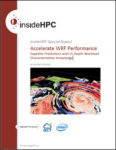For decades, understanding the behavior of a nuclear mushroom cloud was done with careful analysis of observations made during the testing era. Old photos, outdated film and incomplete weather data made precise calculations difficult. Now, with results published in Atmospheric Environment, Lawrence Livermore National Laboratory (LLNL) scientists are improving our understanding of nuclear cloud rise using a […]
insideHPC Special Report Accelerate WRF Performance – Expedite Predictions with In-Depth Workload Characterization Knowledge
A popular application that simulates climate change is the Weather and Research Forecasting (WRF) model. This white paper discusses how QCT can work with leading research and commercial organizations to lower the Total Cost of Ownership by supplying highly tuned applications that are optimized to work on leading-edge infrastructure.
WRF Microphysics Optimization
“Microphysics provides atmospheric heat and moisture tendencies. This module has been optimized to take advantage of the Intel Xeon Phi coprocessor. However, some manual optimization can lead to even greater performance gains. By using manual optimizations, the overall speedup on a host CPU (Intel Xeon E5-2670) was 2.8 X, while the performance of running on the Intel Xeon Phi coprocessor was 3.5 X.”






